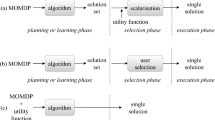Abstract
The problem of finding partners is concerned with how to identify some specific entities (agents) from a group that will be able to provide certain requested services. This problem can readily be found in applications such as file sharing and task allocation in open and/or distributed environments. Previous studies have shown that entities can effectively select their partners by means of evaluating their mutual trust relationships. Here a trust relationship between two entities refers to the establishment of one entity’s belief that another entity will be able to accomplish a service of interest. In this work, we aim to study how the partner-finding problem can be more effectively and efficiently solved by allowing entities to autonomously update their beliefs and hence trust relationships based on their past experiences. In doing so, we introduce the notion of a trust network in which nodes correspond to entities and links represent trust relationships between entities. We apply the methodology of Autonomy-Oriented Computing (AOC) to model and simulate the behavior-based trust relationship updates of entities over time, as well as the structural characteristics of the trust network as being established by entities. Besides providing detailed formulations, we perform a series of experiments to evaluate the impacts of the proposed trust relationship update mechanism on the performance of partner finding.





















Similar content being viewed by others
References
Boccaletti, S., Latora, V., Moreno, Y., Chavez, M., & Hwang, D. U. (2006). Complex networks: Structure and dynamics. Physics Reports, 424(4–5), 175–308.
Clauset, A., Shalizi, C. R., & Newman, M. E. (2009). Power-law distributions in empirical data. SIAM Review, 51(4), 661–703.
Crane, R., Cebrian, M., Pickard, G., Pan, W., & Madam, A. (2009). Team MIT’s strategy in DARPA balloon challenge.
Debenham, J. (2004). A bargaining agent aims to ‘play fair’. In Proceedings of the 24th international conference on innovative technique and applications of artificial intelligence (pp. 173–186).
Erete, L., Ferguson, E., & Sen, S. (2008). Learning task-specific trust decisions. In Proceedings of the 7th international joint conference on autonomous agents and multi-agent systems (pp. 1477–1480).
Golbeck, J. (2008). Weaving a web of trust. Science, 321(5896), 1640–1641.
Golbeck, J., & Hendler, J. (2006). Inferring binary trust relationships in web-based social networks. ACM Transactions on Internet Technology, 6(4), 497–529.
Greeger, M. (2009). CTO roundtable: Cloud computing. Communications of the ACM, 52(8), 50–56.
Hang, C., Wang, Y., & Singh, M. P. (2008). An adaptive probabilistic trust model and its evalution. In Proceedings of the 7th international conference on autonomous agents and multi-agent sytems (pp. 1485–1488).
Hayes, B. (2008). Cloud computing. Communications of the ACM, 51(7), 9–11.
Herrnstein, R. J., & Murray, C. (1994). The bell curve. New York: Free Press.
Hu, H., & Wang, L. (2005). A brief history of power law distributions. Physics, 34(12), 889–896.
Jøsang, A., Ismail, R., & Boyd, C. (2007). A survey of trust and reputation systems for online service provision. Decision Support Systems, 43, 618–644.
Kamvar, S. D., Schlosser, M. T., & Garcia-Molina, H. (2003). The eigentrust algorithm for reputation management in P2P networks. In Proceedings of the 12th international world wide web conference (pp. 640–651).
Liu, J. (2008). Autonomy-Oriented Computing (AOC): The nature and implications of a paradigm for self-organized computing (keynote talk). In Proceedings of the 4th international conference on natural computation and the 5th international conference on fuzzy systems and knowledge discovery (pp. 3–11).
Liu, J., Jin, X., & Tsui, K. C. (2005a) Autonomy-Oriented Computing (AOC): Formulating computational systems with autonomous components. IEEE Transactions on Systems, Man, and Cybernetics-Part A: Systems and Humans, 35(6), 879–902.
Liu, J., Jin, X., & Tsui, K. C. (2005b). Autonomy-Oriented Computing: From problem solving to complex systems modeling. Springer.
Marsh, S. P. (1994). Formalising trust as a computational concept. Ph.D. thesis, University of Stirling.
Newman, M. E. J. (2003). The structure and function of complex networks. SIAM Review, 45(2), 167–256.
Ramchurn, S. D., Huynh, T. D., & Jennings, N. R. (2004). Trust in multi-agent systems. The Knowledge Engineering Review, 19(1), 1–25.
Sabater, J., & Sierra, C. (2005). Review on computational trust and reputation models. Artificial Intelligence Review, 24, 33–60.
Wang, Y., & Singh, M. P. (2007). Formal trust model for multiagent systems. In Proceedings of the 20th international joint conference on artifical intelligence (pp. 1551–1556). San Mateo, CA: Morgan Kaufmann.
Watts, D. J., & Strogatz, S. H. (1998). Collective dynamics of ‘small-world’ networks. Nature, 393(4), 440–442.
Weerdt, M., Zhang, Y., & Klos, T. (2007). Distributed task allocation in social networks. In Proceedings of the 6th international joint conference on autonomous agents and multi-agent systems (pp. 14–18).
Zhang, S., & Liu, J. (2007). Autonomy-oriented social networks modeling: Discovering the dynamics of emergent structure and performance. International Journal of Pattern Recognition and Artificial Intelligence, 21(4), 611–638.
Acknowledgements
This work was supported by the National Natural Science Foundation of China Grant (60673015), Beijing Natural Science Foundation (4102007), Open Foundation of Key Laboratory of Multimedia and Intelligent Software (Beijing University of Technology), the Hong Kong Research Grants Council grant (210508/32-08-105), and the Major State Basic Research Development Program of China (973 Program)(2003CB317001).
Author information
Authors and Affiliations
Corresponding author
Additional information
A preliminary version of this paper was presented at the 5th International Conference on Active Media Technology (AMT’09), October 22–24, Beijing, China.
Rights and permissions
About this article
Cite this article
Liu, J., Qiu, H., Zhong, N. et al. A dynamic trust network for autonomy-oriented partner finding. J Intell Inf Syst 37, 89–118 (2011). https://doi.org/10.1007/s10844-011-0150-y
Received:
Revised:
Accepted:
Published:
Issue Date:
DOI: https://doi.org/10.1007/s10844-011-0150-y




